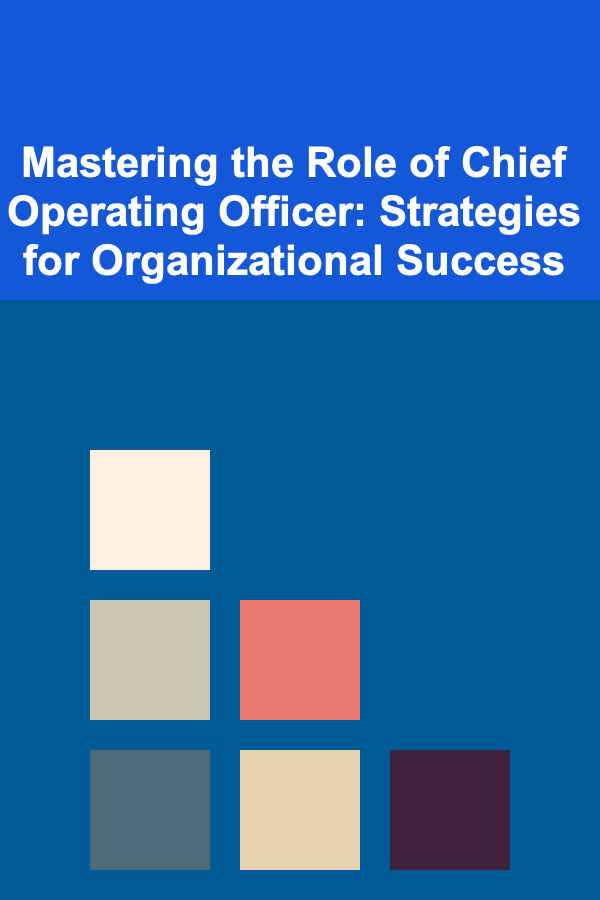
Mastering the Role of Chief Operating Officer: Strategies for Organizational Success
ebook include PDF & Audio bundle (Micro Guide)
$12.99$11.99
Limited Time Offer! Order within the next:

The role of the Chief Operating Officer (COO) is often one of the most pivotal in an organization. Acting as the operational backbone of the company, the COO is responsible for translating strategic vision into effective execution. Whether it's optimizing workflows, enhancing team performance, or driving financial sustainability, the COO's contributions are vital to achieving long-term organizational success. This guide will delve into the key strategies for mastering the COO role, providing a comprehensive roadmap for aspiring and current COOs alike.
Understanding the Role of the COO
The COO is typically the second-in-command in a company, often working closely with the Chief Executive Officer (CEO) to ensure smooth daily operations. The role can vary widely depending on the size, industry, and structure of the organization. However, the common denominator is the COO's responsibility for managing operational functions across the business, ensuring that processes, resources, and people are aligned to execute the company's strategic objectives.
Key functions of a COO include:
- Overseeing daily operations: Managing and improving the internal systems and processes.
- Implementing strategy: Ensuring that strategic goals are translated into executable plans.
- Managing resources: Ensuring that the company has the right tools, technology, and talent.
- Driving growth: Identifying areas of operational improvement to foster business expansion and profitability.
- Fostering company culture: Creating an environment where operational excellence can thrive.
Mastering this role requires a combination of strategic thinking, operational know-how, and strong leadership skills. Let's explore how a COO can develop these capabilities to drive organizational success.
Building a Strong Operational Foundation
At the heart of any successful organization is a strong operational infrastructure. The COO must focus on optimizing key business processes to ensure efficiency and alignment with organizational goals.
Key Actions for Operational Mastery:
- Process Mapping and Improvement: Start by mapping out key business processes. This allows the COO to identify inefficiencies, bottlenecks, or areas where improvements can be made. Use tools like business process mapping software (e.g., Lucidchart or Microsoft Visio) to visualize workflows and track areas requiring optimization.
- Adopting Lean Principles: Lean methodologies focus on eliminating waste and increasing value. By adopting Lean principles such as Kaizen (continuous improvement) and Just-in-Time (JIT) inventory management, the COO can streamline operations and reduce costs. These principles ensure that every part of the business adds value to the customer.
- Standardizing Operations: For scalability and consistency, it is essential to create standard operating procedures (SOPs) for all major operational processes. SOPs provide clear guidelines for employees and help ensure that operations are predictable and repeatable.
- Measuring Performance: Regularly track and analyze operational metrics to ensure that the organization is meeting its performance targets. Key performance indicators (KPIs) like operational cost, cycle time, customer satisfaction, and employee productivity should be closely monitored to drive improvements.
Tools and Resources:
- Process Mapping: Lucidchart, Visio
- Lean Methodology Tools: LeanKit, KanbanFlow
- KPI Tracking: Tableau, Power BI
Leveraging Technology for Operational Excellence
In today's digital age, technology is a game-changer for achieving operational excellence. From automation to real-time data analysis, leveraging the right technologies can enhance operational efficiency, reduce costs, and improve decision-making.
Key Actions for Technological Mastery:
- Automation of Repetitive Tasks: One of the quickest ways to improve efficiency is to automate routine tasks. Processes such as inventory management, payroll, and invoicing can be automated with software tools like Zapier, HubSpot, or QuickBooks. This reduces the time spent on mundane tasks and frees up resources for higher-value activities.
- Implementing Enterprise Resource Planning (ERP): ERP systems like SAP, Oracle, or NetSuite integrate various operational functions---finance, HR, supply chain, etc.---into a single system. This allows for better coordination, real-time data visibility, and faster decision-making across the organization.
- Data-Driven Decision-Making: Modern BI tools, such as Tableau and Power BI, enable COOs to analyze data from across the organization and make informed decisions. With real-time dashboards and predictive analytics, a COO can anticipate issues, spot trends, and make adjustments before problems arise.
- Cloud Computing and Collaboration Tools: Cloud platforms like Google Workspace, Microsoft 365, and Slack enable teams to collaborate seamlessly, regardless of location. These tools help streamline communication, file-sharing, and project management, fostering a more agile and responsive workforce.
Tools and Resources:
- Automation Tools: Zapier, HubSpot, QuickBooks
- ERP Systems: SAP, Oracle, NetSuite
- BI Tools: Tableau, Power BI
- Collaboration Platforms: Slack, Microsoft Teams, Google Workspace
Optimizing the Supply Chain and Vendor Relationships
A well-managed supply chain can be a significant competitive advantage, while a poorly managed one can lead to operational inefficiencies, customer dissatisfaction, and higher costs. The COO must ensure that the supply chain is agile, cost-effective, and resilient to disruptions.
Key Actions for Supply Chain Mastery:
- Streamlining Inventory Management: Use technology like RFID or barcode scanning systems to optimize inventory tracking. Tools like TradeGecko or NetSuite can help manage stock levels, track inventory in real time, and reduce the risk of stockouts or overstocking.
- Supplier Relationship Management: Build strong relationships with key suppliers to ensure reliability and quality. COOs should negotiate favorable terms, assess supplier performance regularly, and foster long-term partnerships that benefit both parties.
- Forecasting and Demand Planning: Accurate demand forecasting is crucial for ensuring that the supply chain can meet customer needs without incurring excessive costs. Implement demand planning tools like Forecastly or RELEX to better predict customer demand and optimize production schedules.
- Supply Chain Risk Management: Identify potential risks in the supply chain, such as geopolitical issues or natural disasters, and develop contingency plans. Diversifying suppliers and developing alternate logistics channels can help mitigate these risks.
Tools and Resources:
- Inventory Management Systems: TradeGecko, NetSuite
- Demand Forecasting Tools: Forecastly, RELEX
- Supplier Management Platforms: SAP Ariba, Oracle Procurement Cloud
Financial Stewardship and Budget Management
A COO plays a crucial role in managing the company's financial health. This includes ensuring that operational budgets are adhered to, resources are allocated efficiently, and financial performance aligns with organizational goals.
Key Actions for Financial Mastery:
- Cost Control: Regularly monitor and control costs across various operational functions. Analyze expenditure patterns and identify areas for cost-cutting, such as renegotiating supplier contracts or reducing waste in production processes.
- Profitability Analysis: Conduct profitability analysis for different product lines or departments. Understanding which areas of the business are most profitable can help inform decisions on resource allocation, pricing strategies, and investment.
- Budget Planning and Forecasting: Collaborate closely with the CFO to develop accurate budgets and financial forecasts. Having a clear understanding of revenue, costs, and cash flow helps ensure that the organization remains financially stable while scaling operations.
- Investing in Growth: Operational investments, such as new technology, training programs, or process improvements, should be carefully assessed for their potential return on investment (ROI). COOs should prioritize projects that align with strategic growth objectives and deliver measurable results.
Tools and Resources:
- Financial Management Software: QuickBooks, Xero, FreshBooks
- Cost Control Tools: Expensify, Concur
- Budget Planning Software: Adaptive Insights, Float
Leading and Developing Teams
A high-performing team is the cornerstone of any successful operation. The COO must focus on building, nurturing, and retaining talent to ensure that the organization has the human resources needed to achieve operational goals.
Key Actions for Team Leadership Mastery:
- Clear Communication and Vision: As a COO, it is essential to communicate the company's strategic vision clearly and consistently to your team. Everyone should understand how their roles contribute to the larger goals of the organization.
- Investing in Employee Development: Provide training and development opportunities that align with both the company's needs and employees' personal growth. This can include technical skills training, leadership development, or cross-functional collaboration initiatives.
- Fostering Accountability and Collaboration: Create a culture of accountability by setting clear expectations for performance. Use project management tools like Asana or Trello to track progress and ensure that teams stay on target. Foster collaboration by encouraging interdepartmental communication and joint problem-solving.
- Employee Engagement: Engage employees by recognizing achievements, soliciting feedback, and fostering a positive work environment. High employee engagement leads to better performance, greater innovation, and improved retention rates.
Tools and Resources:
- Employee Engagement Platforms: Officevibe, TINYpulse
- Project Management Tools : Asana, Trello, Monday.com
- Learning Management Systems: Udemy, LinkedIn Learning
Navigating Crisis and Change Management
In a rapidly changing world, crises are inevitable. Whether it's a market downturn, operational failure, or a sudden shift in customer behavior, the COO must be prepared to lead the organization through turbulent times.
Key Actions for Crisis Management Mastery:
- Preparedness and Risk Mitigation: Identify potential crises in advance and develop contingency plans. This includes business continuity plans, disaster recovery protocols, and supply chain diversification.
- Crisis Communication: Clear, transparent communication is critical during a crisis. Ensure that all stakeholders---employees, customers, investors---are kept informed with timely updates. Use communication tools like Everbridge or OnSolve to disseminate information quickly.
- Post-Crisis Analysis: After a crisis has been resolved, conduct a post-mortem to evaluate the response and identify lessons learned. Use this feedback to refine future crisis management strategies and improve organizational resilience.
Tools and Resources:
- Crisis Management Software: Everbridge, OnSolve
- Risk Management Tools: RiskWatch, Resolver
Conclusion
Mastering the role of the Chief Operating Officer requires a blend of strategic vision, operational expertise, financial acumen, and leadership ability. By focusing on optimizing operational processes, leveraging technology, managing resources effectively, and fostering a culture of accountability and engagement, a COO can drive organizational success. In today's dynamic business landscape, the role of the COO is more critical than ever---mastering it can position an organization for sustained growth and competitive advantage.

How to Test Your Product for Compliance with Industry Standards: An Actionable Guide
Read More
The Art of Technical Writing: Best Practices for Clear and Concise Content
Read More
How to Foster Independent Learning Skills
Read More
Grasping the Latest in Wound Healing Technologies
Read More
How to Plan a Product Launch for Digital Products
Read More
10 Tips for Improving Your Pop-Up
Read MoreOther Products

How to Test Your Product for Compliance with Industry Standards: An Actionable Guide
Read More
The Art of Technical Writing: Best Practices for Clear and Concise Content
Read More
How to Foster Independent Learning Skills
Read More
Grasping the Latest in Wound Healing Technologies
Read More
How to Plan a Product Launch for Digital Products
Read More